Creating the ideal Bearded dragon setup
Bearded dragons are one of the most popular reptiles kept in the pet trade, and for good reason. They are intelligent, easily tamed and fairly easy to take care of. In this help guide, we will cover how to create the ideal setup for your Bearded dragon.
For full details on how to take care of a Bearded dragon, please see our dedicated Bearded dragon care sheet.
Bearded dragon tank size
Bearded dragons love to explore and are sizable lizards with high activity levels, so their enclosure must be large enough not only to produce a proper thermogradient, but to allow them enough space for exercise and enrichment. Due to their semi-arboreal habits, the enclosure should not only provide plenty of floor space but some vertical space too.
We recommend a minimum enclosure size of 120 x 60 x 60cm (4 x 2 x 2ft) to house an adult Bearded dragon, although if you have the option to go larger, this will definitely be beneficial, allowing you to create an even better Bearded dragon habitat. Adult bearded dragons are renowned for being highly territorial, solitary animals, so multiple individuals should never be kept in a single vivarium, not even for breeding.
Young Bearded dragons can quite happily live in slightly smaller setups, although this tends to increase the overall cost, as an upgrade will be needed down the line, so we recommend purchasing the adult-sized vivarium from the beginning to avoid unnecessary costs in the future.
Wooden vivariums tend to work better for Bearded dragons than glass terrariums or PVC plastic enclosures, as wood is a better insulator, and works better to maintain the hot temperatures required by a Beardie. A PVC or glass terrarium can still be used, however, extra care will need to be taken to keep the temperatures within the optimum range, particularly with the screen lid present on most glass terrariums.
To simplify things for our customers when building their new Bearded dragon habitat setup, our experts have created a number of Bearded dragon starter kits for Bearded dragons of all ages, so why not take a look at those. If you're unsure on which starter kit to choose, check out our Beardie starter kit help guide.
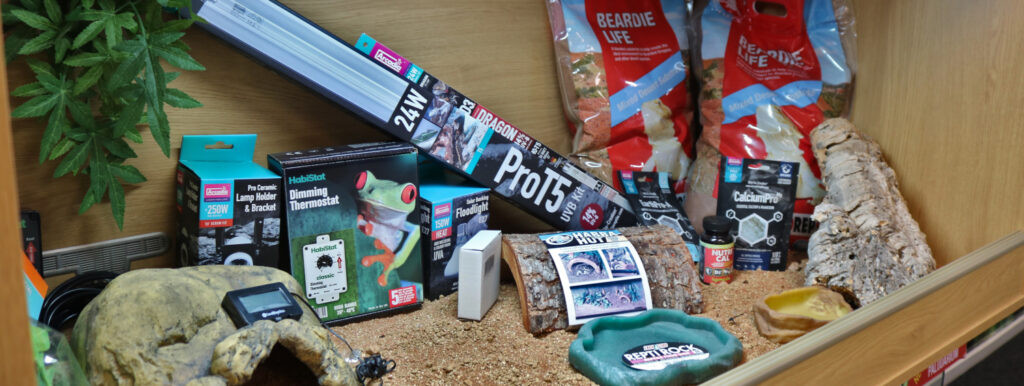
Bearded dragon heating
To create a natural Bearded dragon habitat, they require an environment that is hot and dry, whilst still having cooler areas to cool down when required. When a Bearded dragon is too hot, they will rest with their mouths open and their colours will brighten up, whereas if a Bearded dragon is too cold, their colours will darken, to allow them to absorb as much heat as possible.
To enable them to control their internal body temperature, and properly digest their food, a Bearded dragon enclosure should have a thermogradient running from one end to the other. The temperature gradient for a Bearded dragon should run from 40°C (104°F) in the hot side (the basking temperature), and 25°C (77°F) being the cool side temperature.
Heat should be provided in the form of an overhead heating element, either a heat lamp or a ceramic heat emitter under which they can bask, although, we recommend using a basking light over a ceramic heater, due to visible light produced, either option can be used suitably. Heat mats do not tend to work well enough to warm the ambient air temperature in the entire enclosure and produce a thermogradient across this size tank.
It is of utmost importance that all heating equipment is regulated by a compatible thermostat, which would be a dimming thermostat for a basking light or a pulse proportional thermostat for a ceramic heater, and that at least two accurate thermometers are used to monitor the temperature in both the hot side and cool side.
As the temperature naturally drops quite dramatically overnight, it is highly unlikely that you will need to provide any nighttime heating to your Bearded dragon, in fact, it is more beneficial to allow this temperature drop as it more closely replicates their native environment.
If your home drops below around 15°C (59°F), then it will be worth providing some supplementary nighttime heating, using a non-light emitting heat source such as a ceramic heat emitter, but this should still be set to a much lower temperature than during the day to still allow for a nighttime temperature drop.
For more detailed information regarding Bearded dragon heating, please see our dedicated Bearded dragon heating guide.
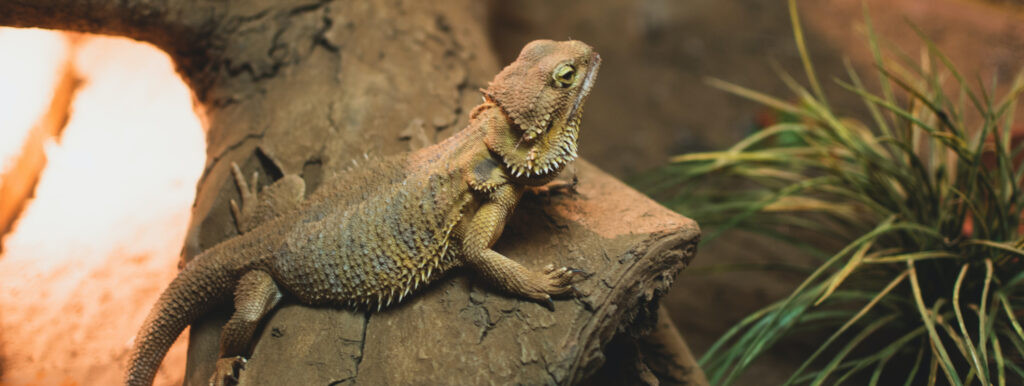
Bearded dragon lighting
To allow them to metabolise vitamin D, and in turn, properly assimilate and bind the calcium provided in their diet, Bearded dragons need high-level, full-spectrum lighting. Without this, they are likely to develop serious health issues such as metabolic bone disease (MBD), which causes the bones to become weakened, leading to deformities, weakness, fractures, tremors, and in extreme cases, death.
Bearded dragons are best kept within a UVI (UV Index) ranging between 4-6, although the percentage of the UVB light required to achieve this will differ depending on the light fitting type, and the distance between the light itself and your Bearded dragon's highest basking perch, termed the minimum safe distance.
Coil UVB bulbs do not produce adequate amounts of UVB for a Bearded dragon, so we recommend against the use of these for these species. Instead, a tube UVB light should be used, either a T5 or T8 tube. T5 tubes are more modern, slimmer, last longer and produce more light per wattage of electricity, so are definitely a superior option to the more dated T8 tubes, although they can still be used at smaller distances.
If your light fixture will be between 25-30cm (10-12") from the highest basking point, either a 6% T5 tube, or 12% T8 tube can be used. If this distance will instead be between 30-45cm (15-18") from the highest basking area, a 12% T5 should be used. Finally, if your light will be between 45-60cm (18-24") from the highest basking point, then a 14% T5 tube should be used.
It is most recommended to have your visible light fixtures (including basking lamps) on a 12 hour on/off cycle, which can either be done manually or using a timer. This will produce a natural day/night cycle, letting your Bearded dragon know when it is time to be active and ensuring its circadian rhythm (or sleep cycle) is not interrupted.
All UVB bulbs have a limited lifespan, which differs between fitting types. Although your UV light may still be emitting visible light, the UVB rays will deplete over time, so the tubes must be replaced regularly to account for this. A general rule is to replace T8 tubes every 6 months, or every 12 months for T5 tubes, although you can use a Solarmeter to monitor UV degradation and replace the tubes only when the UVB depletes below optimum levels.
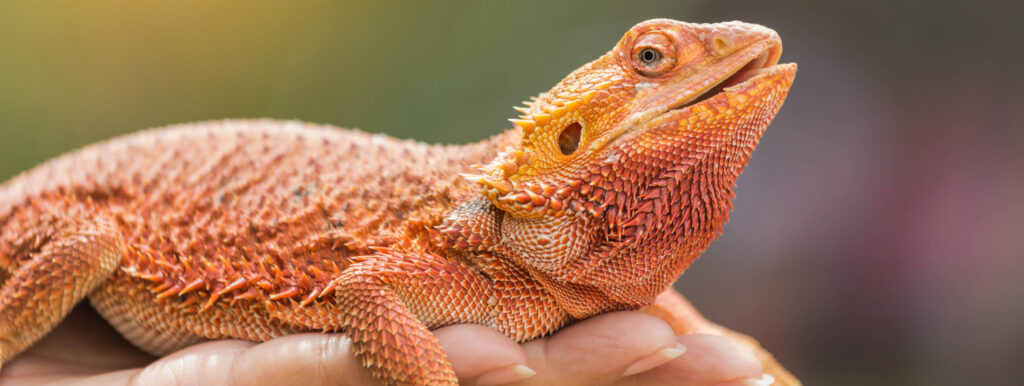
Bearded dragon substrates
Sand is a natural part of a wild Bearded dragon's habitat, although there is some debate in captivity as to whether sand should be used as a substrate for Bearded dragons. This controversy comes from an issue called impaction, essentially when a Beardie ingests so much undigestible substrate that it blocks their digestive tract and they are no longer able to digest their food.
Impaction should, however, not be a cause for concern when all other husbandry requirements are met. Healthy Bearded dragons will not seek out nutrition from their substrate, however, a Bearded dragon suffering from malnutrition will seek out the nutrition they are missing from wherever they can, including the deliberate ingestion of substrate.
At Swell Reptiles, we still recommend the use of sandy, desert substrates for a Bearded dragon, providing they are of high quality, as this will most closely mimic their natural environment whilst still allowing them to exhibit natural burrowing and digging behaviours. However, non-loose substrates such as slate or tiles can also be used with some success.
We recommend against the use of reptile carpet for Bearded dragons, as there have been instances where the dragon's nails have been caught in the carpet causing injury. On top of this, reptile carpet tends to harbour bacteria and is difficult to clean adequately, so although it can still be used for some species, we do not recommend it for the longer clawed and more messy Beardies.
For more detailed information regarding the best substrates for Bearded dragons, why not take a look at our help guide focusing on Bearded dragon substrates.
Bearded dragon tank decoration
To provide enrichment and allow your Bearded dragon to thrive, you should provide plenty of semi-arboreal perches in the form of hammocks, branches and basking platforms along the entire length of the vivarium.
Rough pieces of decor, such as wood pieces or rocks will also help to keep your Bearded dragon's claws down, reducing the risk of related health issues.
Hiding areas should be provided along the length of the enclosure, either using logs, half logs or traditional reptile hides. Further decoration can be provided using foliage, which can either come in the form of live plants, such as Aloe vera or Echeveria in a bioactive Bearded dragon setup, or artificial plastic plants.
Without adequate enrichment, a Bearded dragon is likely to become bored and/or stressed, a classic sign of this in Bearded dragons is glass surfing, which essentially means the dragon is lifting up its body against the glass of its vivarium, seeking more space or enrichment. This behaviour alone is not dangerous, but signals a wider issue with the Bearded dragon's tank setup that should be addressed to avoid unnecessary stress.
It is also important to provide a shallow water dish on the cool side, away from the basking lamp, to provide hydration without increasing the overall humidity levels, and a shallow food bowl for your Bearded dragon's greens to go in, minimising the risk of substrate ingestion whilst eating.
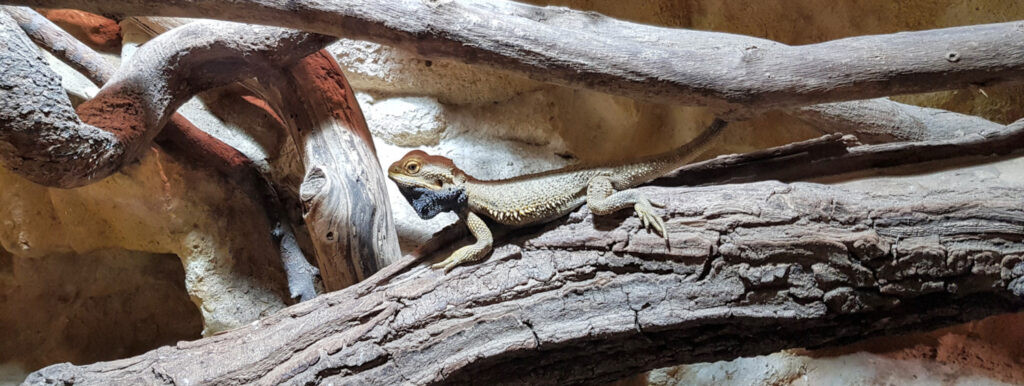
Summary
In summary, to create the perfect Bearded dragon habitat, you need a large enclosure, a heating system (basking bulb or ceramic and relevant thermostat), a high-quality UVB fluorescent bulb, with the strength tailored to your enclosure size, substrate (loose or slate/tile), plenty of decor, a water bowl and a food bowl.
Having all of the above together will ensure your Bearded dragon can live a long, happy and healthy life as your pet, whilst also producing a stunning habitat for you to stare at for hours on end.
While you're thinking about creating your Bearded dragon setup, why not take a look through our Bearded dragon starter kits and get everything you need in one go?




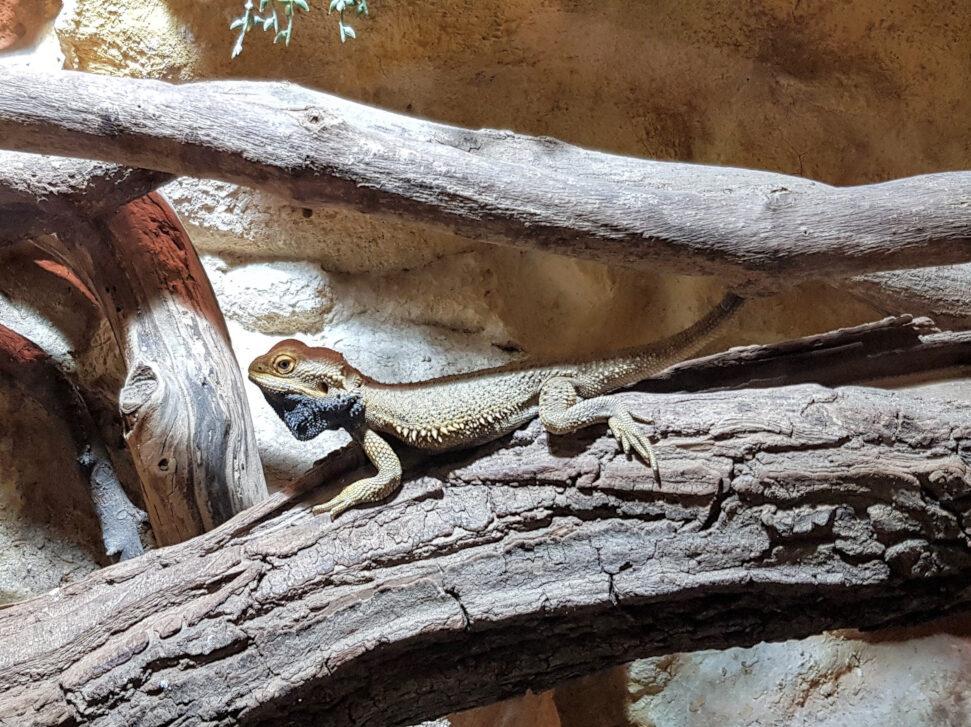
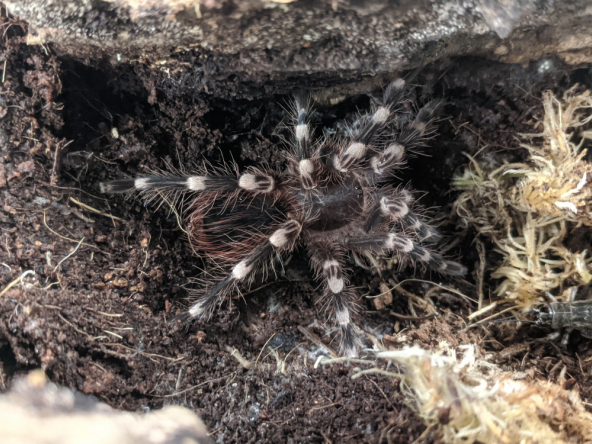
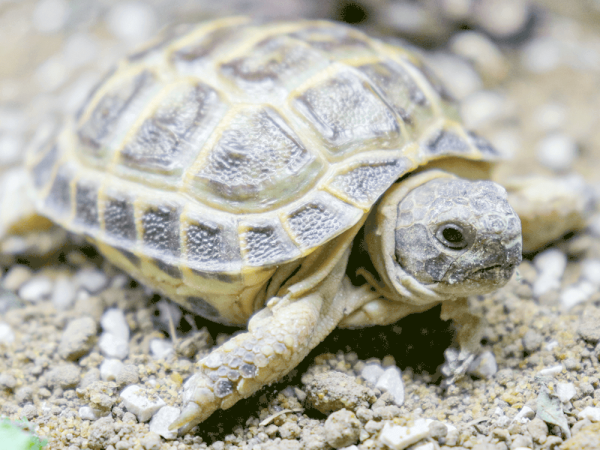
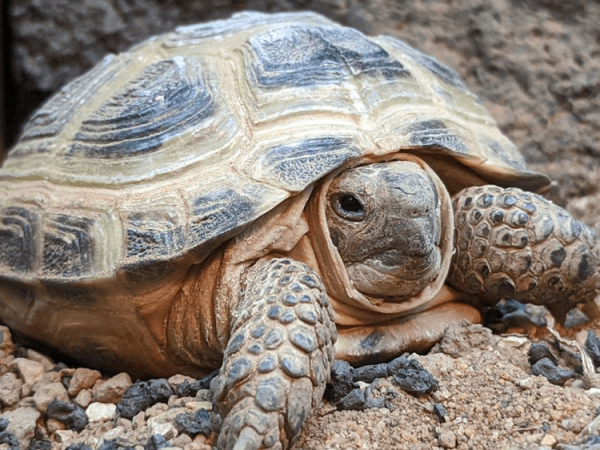
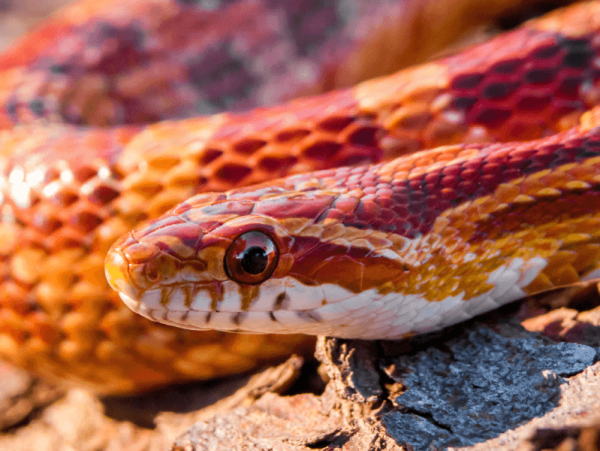
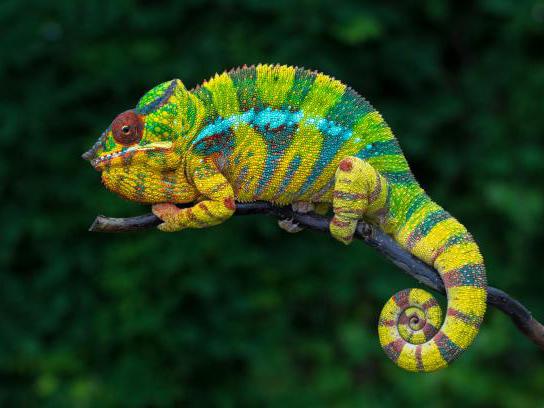
Thank you for your comment.
It is likely that if your Beardie is refusing food that this is the reason he isn't passing any waste at the moment, as he doesn't have anything to pass. They can be quite stubborn when it comes to getting them to eat foods that they aren't keen on or would normally leave behind, but perseverance is key.
We do have another help guide focused on feeding issues in Bearded dragons (https://www.reptiles.swelluk.com/help-guides/why-is-my-bearded-dragon-not-eating/) however, this is more focused on identifying why your Bearded dragon may not be eating, so it may not be of much help in your situation as he is likely not eating because he would prefer to be fed the food items forbidden by the vet.
It should not be a cause for concern in the immediate short-term, and hopefully, you can get him eating his greens and crickets soon enough, but if the issue persists, it may be worth consulting again with the vet.
I hope this helps.
Thank you for your comment.
This question is a little difficult to answer as there is no one size fits all rule when it comes to wattages of heating equipment for any specific animal. This is because the heating elements will only serve to increase the current temperature by a certain amount, for example, if you have a 100w bulb in a cold room, the resulting temperature under the lamp will be cooler than it would if you had the same bulb in a warm room. This means you can often find yourself in a bit of a trial and error situation, trying different wattages until you find the right one.
Since Bearded dragons require warmer basking temperatures than a lot of other reptiles, you generally need a bulb with a higher wattage to reach this. If you are using a thermostat, it would not hurt to use a 150w basking lamp, as although it may potentially get too hot if unregulated, the thermostat will prevent this, but the bulb shouldn't have any issues reaching temperature, whereas, a lower wattage bulb could struggle to reach the 40°C (104°F) required.
I hope this helps.